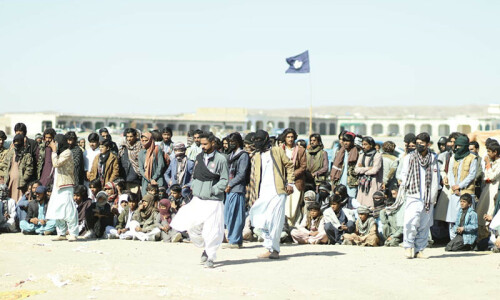KARACHI, Jan 31: There is a clear distinction between Islamic revolutionary movements and fundamentalism, as the former emphasises that the problems of Muslims can be solved by referring to the teachings of Islam, while the latter favours a forceful imposition of Islam and detaches itself from reality.
This was stated by Dr Seyed Rasoul Mousavi, director-general, Institute of Political and International Studies, Ministry of Foreign Affairs of the Islamic Republic of Iran.
The scholar was speaking at a seminar titled ‘Islamic Revolution of Iran: consequences and achievements’ on Saturday, organised by the Pakistan Institute of International Affairs (PIIA), in collaboration with the Pak-Iran Friendship Association. The seminar was held at the PIIA library.
“There is a big difference between the Islamic Revolution and fundamentalism. There are many classifications of Islamic movements e.g. Shia and Sunni, while others say there is political, militant and moderate Islam, while some also differentiate between radical and moderate Islam. But all Islamic movements can be divided into two classes, philosophically speaking.
“With the (revolutionary approach) Muslims feel all their problems can be solved by referring to Islamic thought. In Iran our problem was the Shah’s regime. We turned to Islamic teachings for the revolution. In fundamentalism, it is thought that only by accepting Islam will we find all the solutions to our problems. It emphasises creating a regime by force. Fundamentalism is based on blind acceptance, closing your eyes,” said Dr Mousavi.
When asked if there was a danger of a revolutionary movement transforming into a fundamentalist one, the scholar said the Islamic Revolution was based on Ijtehad, and a society based on Ijtehad stands as a bulwark against fundamentalism.
Talking about some of the factors behind Iran’s Islamic Revolution, Dr Mousavi said that as far back as 1963, long before the revolution triumphed in 1979, Ayatollah Ruhollah Khomeini – the revolution’s guide – had opposed Israel for occupying Muslim lands. He said there was mass support for the revolution, as the unarmed masses took to the streets without artillery, machine guns and tanks. “The revolution was a mixture of Iranian civilisation, culture and Islamic thought.”
He also dwelt on the question of whether the Islamic Revolution was unique to Iran, or if it could be replicated in other Muslim nations.
“It was unique in Iran, but as a theory it can be modelled elsewhere. Will it be like Iran in other places? No. The revolution is part of the renaissance in the Islamic world,” he said, naming such leaders and thinkers of the modern Islamist movement as Sayyid Jamaluddin Afghani Asadabadi, Mohammad Abduh, Allama Mohammad Iqbal and Syed Abul Ala Maududi.
Dr Mousavi also questioned if the Islamic world was a reality or just an idea. He claimed that Muslims were now finding their identity and that events such as the recent “tragedy of Gaza” had brought together “not just Muslims from Indonesia to Morocco, but all human beings, including people of Europe and Latin America.
Revolutionary theory
“In Iran there is one angle. In Lebanon there is another, in Palestine another. All these are Islamic revolutions. ‘Muslims, brothers … unite and solve your problems.’ This is theoretically Islamic revolution. Islam is in our hearts, but we distinguish between realities,” he said, adding that the conditions in each country were unique.
Iranian Ambassador to Pakistan Mashallah Shakeri began his address speaking in fluent Urdu, which he said he had learnt when he came to Pakistan. He asked the audience’s permission to deliver his lecture in English, though he claimed English did not have the sweetness of Urdu.
He said Islam, leadership and the people were the prominent characteristics of the Islamic Revolution in Iran. “The revolution was one of the most important events of the twentieth century that had major impact (on) global equations,” the ambassador added.
Mr Shakeri said Iran’s “strategic location and energy resources had made it the focus of attention and rivalry of the great powers in the contemporary era.” He added that Iran had tried to forge an independent post-revolutionary foreign policy free from foreign influence, as during Qajar rule Iran had been turned into a “semi-colonial country” while things were not much better during the Pahlavi regime.
The ambassador also made it clear that his country wanted stability in Pakistan. “Stabilisation of a strong and prosperous Pakistan will bring peace of mind to Iran as a well-wishing neighbour. Iran, in 1947, was among the early countries that officially recognised Pakistan.”
Mr Shakeri said that the relationship between Iran and Pakistan would be strengthened despite irritants like the kidnapping of Iranian diplomat Hashmatullah Attarzadeh from Peshawar, who remains untraced. The ambassador concluded his lecture with a passionate rendition of Iqbal’s verses.
Iranian Consul-General Masoud Mohammad-Zamani delivered his whole speech in Urdu and urged his fellow diplomats to learn the national language of Pakistan. He said the “blue eyed, fair skinned ones had cut you off from Rumi, Hafiz, Sa’adi and Iqbal,” adding that since Allama Iqbal used firm language against imperialists in his poetry, Farsi was bound to become a target.
Referring to the Islamic Revolution, he said Imam Khomeini urged his followers to do their part, as ensuring the result was not their duty. He said the revolution was aided by divine help, while adding that to change the external conditions, it was imperative to change the internal conditions. He concluded his speech, laden with the sublime verses of Iqbal, by quoting Ayatollah Ali Khamenei, Supreme Leader of Iran, who said the real victors of the revolution were the deprived masses who gave their blood for the cause.
PIIA chairman Fatehyab Ali Khan presided over the event.

















































Dear visitor, the comments section is undergoing an overhaul and will return soon.